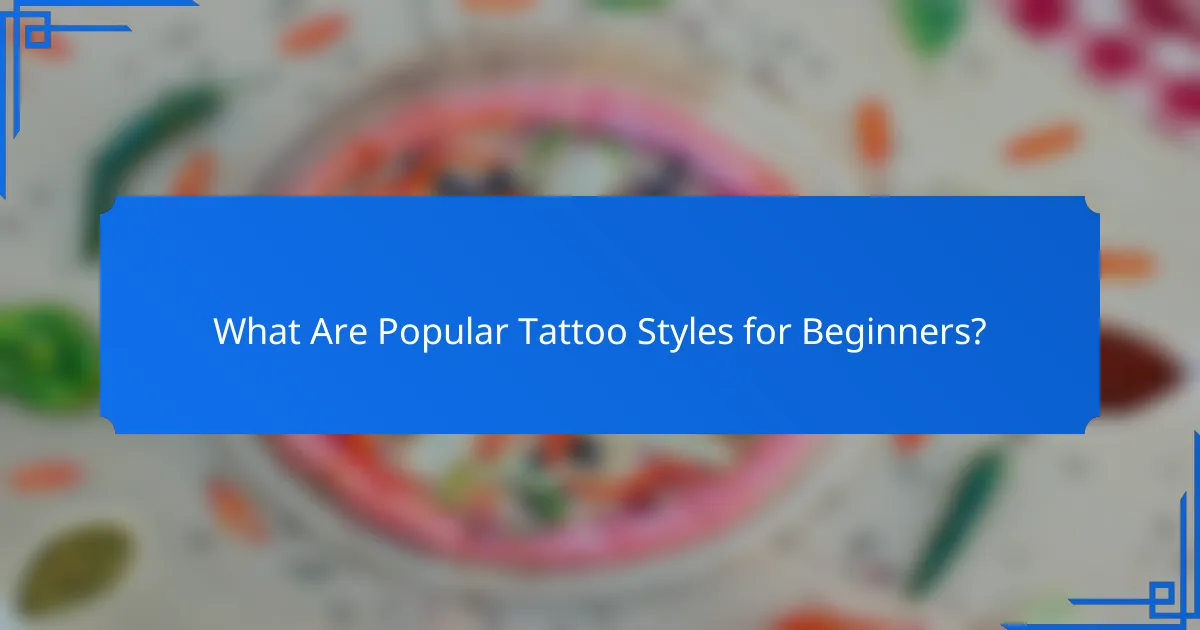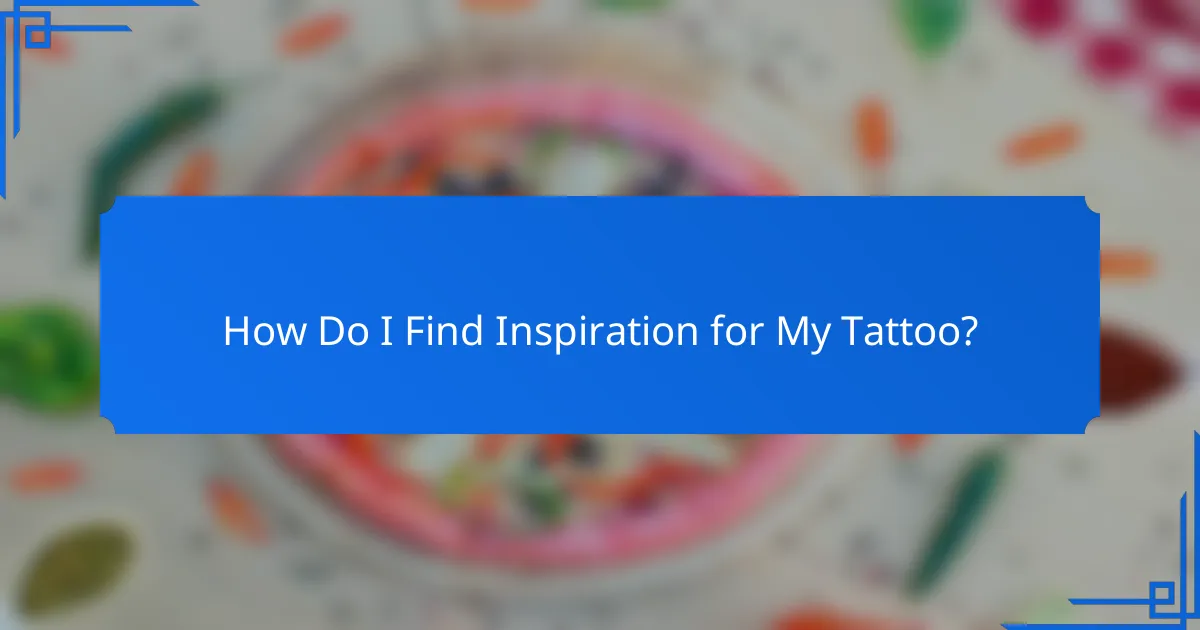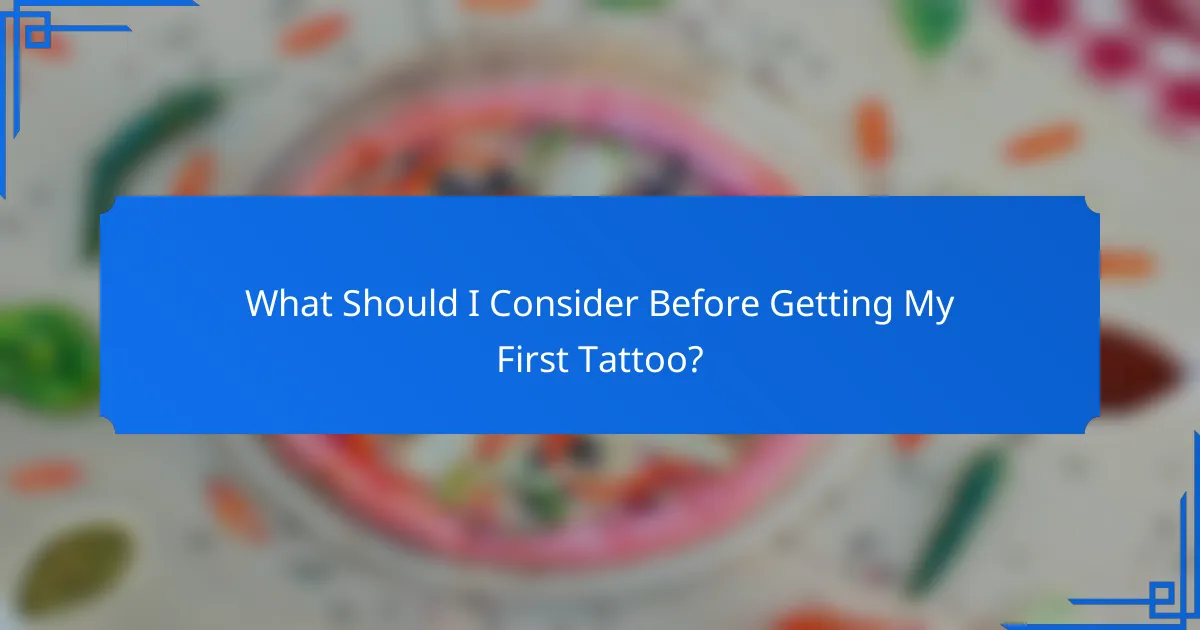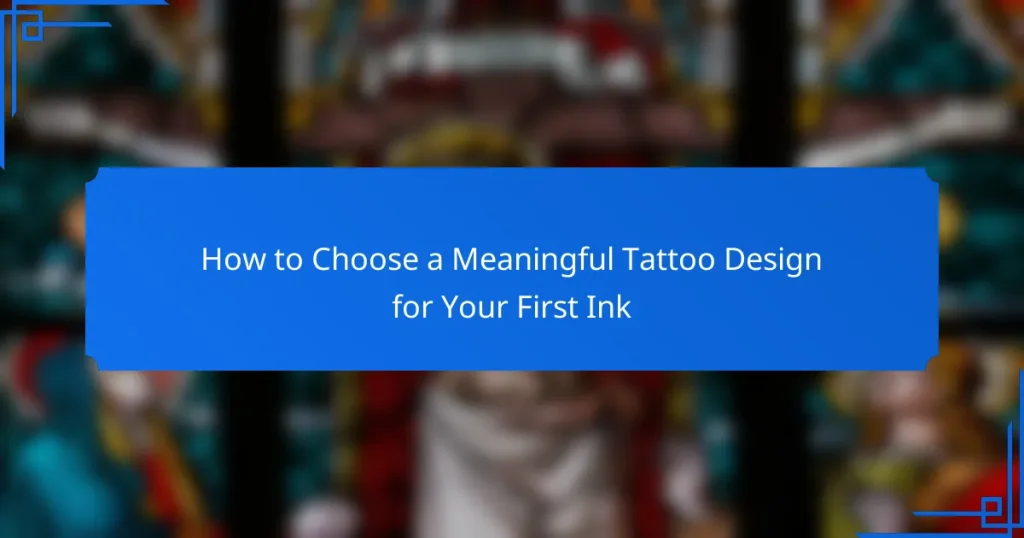Choosing a meaningful tattoo design for your first ink is an important decision that reflects your personal values and experiences. Take the time to explore what resonates with you, whether it’s a significant life event, cultural influence, or a personal belief, to ensure your tattoo truly represents who you are. Popular styles like minimalist or watercolor can offer a beautiful canvas for your unique story, making them ideal for beginners.

How Do I Choose a Meaningful Tattoo Design?
Choosing a meaningful tattoo design involves reflecting on what resonates with you personally and what you want to express through your ink. Focus on your values, significant experiences, and cultural influences to create a design that truly represents you.
Identify personal values
Your personal values are the foundation for a meaningful tattoo. Consider what principles guide your life, such as love, freedom, or resilience. A tattoo that embodies these values can serve as a constant reminder of what matters most to you.
To identify your values, make a list of qualities you admire in others or aspire to embody yourself. Narrow this down to a few key themes that resonate deeply with you, which can then inspire your tattoo design.
Consider significant life events
Significant life events can provide rich inspiration for a tattoo. Reflect on milestones such as graduations, births, or personal challenges that have shaped who you are. A tattoo commemorating these moments can serve as a powerful symbol of your journey.
Think about using dates, symbols, or quotes that represent these experiences. For example, a date in Roman numerals or a symbol that reflects a personal triumph can make your tattoo uniquely meaningful.
Explore cultural symbols
Cultural symbols can add depth and significance to your tattoo design. Research symbols that resonate with your heritage or beliefs, as they can convey messages of identity and connection. This can also include symbols from cultures you admire or feel a connection to.
Ensure you understand the meaning and context of any cultural symbols you choose to avoid misrepresentation. Consulting with knowledgeable sources or individuals from that culture can provide valuable insights.
Consult with tattoo artists
Consulting with tattoo artists can help refine your ideas into a cohesive design. Experienced artists can offer creative suggestions and help you visualize your concept. They can also advise on placement and size to ensure your tattoo looks great and fits your body.
When meeting with an artist, bring your ideas, sketches, or reference images. Be open to their input, as they may suggest modifications that enhance the overall design while keeping it meaningful to you.

What Are Popular Tattoo Styles for Beginners?
Popular tattoo styles for beginners often include minimalist, watercolor, and traditional designs. These styles are generally easier to execute and can carry significant personal meaning, making them ideal for first-time ink enthusiasts.
Minimalist tattoos
Minimalist tattoos focus on simplicity and clean lines, making them a great choice for beginners. These designs often use basic shapes or symbols, allowing for personal interpretation without overwhelming detail.
When considering a minimalist tattoo, think about what symbols resonate with you. Common choices include geometric shapes, small animals, or meaningful words. The simplicity of these tattoos can make them timeless and versatile.
Watercolor tattoos
Watercolor tattoos mimic the look of watercolor paintings, featuring vibrant colors and fluid designs. This style can be visually striking and allows for a lot of creativity, making it appealing for those looking for something unique.
However, watercolor tattoos can be more challenging to execute, so it’s essential to choose an experienced artist. Consider designs that incorporate splashes of color around a central theme, like flowers or abstract shapes, to enhance the artistic effect.
Traditional tattoos
Traditional tattoos, often characterized by bold lines and vibrant colors, have a classic appeal. This style typically features iconic imagery such as roses, skulls, or anchors, which can carry deep cultural meanings.
For beginners, traditional tattoos can be a great way to express personal stories or values. When selecting a design, think about symbols that resonate with your identity or experiences. Ensure you choose a reputable artist familiar with this style to achieve the best results.

How Do I Find Inspiration for My Tattoo?
Finding inspiration for your tattoo can involve exploring various sources that resonate with your personal style and values. Consider your interests, experiences, and the messages you want to convey through your ink.
Use social media platforms
Social media is a treasure trove for tattoo inspiration, with platforms like Instagram and Pinterest showcasing countless designs. Search for hashtags related to tattoos, such as #tattooideas or #inked, to discover artists and styles that appeal to you.
Engage with tattoo communities online to see what others are sharing and to get feedback on your ideas. Following tattoo artists can also provide insight into their portfolios and unique styles.
Visit tattoo conventions
Tattoo conventions are excellent venues to find inspiration and connect with artists. These events often feature a variety of tattoo styles, allowing you to see work up close and in person.
Attending a convention gives you the chance to discuss your ideas with artists, ask questions, and even book appointments for your tattoo. Look for local conventions in your area or larger events that attract top talent.
Browse tattoo magazines
Tattoo magazines can provide a curated selection of designs and artist features that may spark your creativity. Many magazines showcase trends, interviews, and galleries of work from various artists.
Consider subscribing to a few reputable tattoo magazines or visiting local shops that carry them. This can help you stay updated on the latest styles and techniques in the tattoo world.

What Should I Consider Before Getting My First Tattoo?
Before getting your first tattoo, consider factors like your skin type, pain tolerance, and aftercare requirements. These elements will help you choose a design that is meaningful and manageable for your lifestyle.
Skin type and placement
Your skin type plays a crucial role in how a tattoo will heal and look over time. Oily skin may cause ink to spread, while dry skin can lead to fading. Understanding your skin type will help you select an appropriate placement for your tattoo.
Placement is also important; areas with more muscle and fat tend to be less painful and heal better. Common placements for first tattoos include the forearm, upper arm, and thigh, which are generally easier to care for and show off.
Pain tolerance
Everyone experiences pain differently, and knowing your pain tolerance can help you choose a suitable tattoo location. Areas with more flesh, like the upper arm or thigh, typically hurt less than bony areas like the ribs or spine.
If you’re concerned about pain, consider starting with a smaller design in a less sensitive area. Many first-timers find that the anticipation is often worse than the actual experience.
Aftercare requirements
Proper aftercare is essential for healing your tattoo and ensuring it looks great long-term. This typically includes keeping the tattoo clean, moisturized, and protected from sun exposure for several weeks.
Be prepared to follow specific aftercare instructions provided by your tattoo artist, which may include avoiding swimming and tight clothing. Understanding these requirements will help you maintain your tattoo’s quality and vibrancy.

How Do I Choose the Right Tattoo Artist?
Choosing the right tattoo artist is crucial for ensuring your tattoo is both meaningful and well-executed. Look for an artist whose style resonates with you and who has a solid reputation for quality work.
Review portfolios
Consider the range of designs they have executed. A versatile artist may be better suited to create a unique piece that reflects your personal story. If possible, ask to see healed tattoos to assess how well their work ages over time.
Check artist credentials
Verify the artist’s credentials, including their training and experience. Many reputable tattoo artists have completed apprenticeships under established professionals, which can indicate a solid foundation in tattooing techniques and safety practices.
Ensure the artist is licensed according to local regulations, which may vary by region. In some places, artists must meet specific health and safety standards, so checking for compliance can provide peace of mind.
Read client testimonials
Client testimonials can offer valuable insights into an artist’s professionalism and customer service. Look for reviews on social media, tattoo forums, or the artist’s website to gauge the experiences of previous clients.
Pay attention to comments regarding the artist’s communication, cleanliness of the studio, and overall satisfaction with the final tattoo. A pattern of positive feedback can be a strong indicator of a reliable tattoo artist.

What Are the Costs Associated with Getting a Tattoo?
The costs associated with getting a tattoo can vary widely based on factors such as the tattoo’s size, complexity, and the artist’s experience. Generally, you can expect to pay for both the time spent on the tattoo and any additional materials used during the process.
Average pricing per hour
On average, tattoo artists charge between $100 and $300 per hour, depending on their skill level and location. In larger cities or areas with a high demand for tattoos, rates may be on the higher end of this spectrum.
When considering the hourly rate, keep in mind that more intricate designs or larger pieces will take longer to complete, thus increasing the overall cost. It’s advisable to discuss your design and budget with the artist beforehand to get a clearer estimate.
Some artists may offer flat rates for specific designs or sizes, which can provide more predictable pricing. Always ask for a detailed breakdown of costs to avoid surprises when settling the bill.


